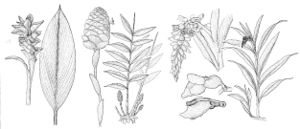Curcuma
Sp. Pl. 1: 2. 1753; Gen. Pl. ed. 5; 3, 1754.
| Taxon | Illustrator ⠉ | |
|---|---|---|
 | Alpinia zerumbet Curcuma zedoaria Zingiber zerumbet |
Pseudostems absent. Inflorescences from rhizome branch without basal leaves [projecting among basal leaves], dense, cylindric; bracts of main axis crowded, [2–] 4–9 cm, ovate to narrowly ovate or rectangular; cincinni sessile, 2–7-flowered, enclosed in bracts; bracteoles small, inconspicuous, hidden by bracts. Flowers: calyx short-cylindric, minutely 2–3-toothed, split down one side; corolla-tube funnelform, lobes ovate or oblong; filament rectangular, plane; anther enclosed in corolla, base spurred, terminal appendage sometimes present, lingulate; lateral staminodes large, petallike, lip concave, rounded or 2-fid. Fruits capsule, ellipsoid. x = 11, 21.
Distribution
Introduced; North America, native, s Asia, Australia
Discussion
Species ca. 50 (1 in the flora).
Selected References
None.